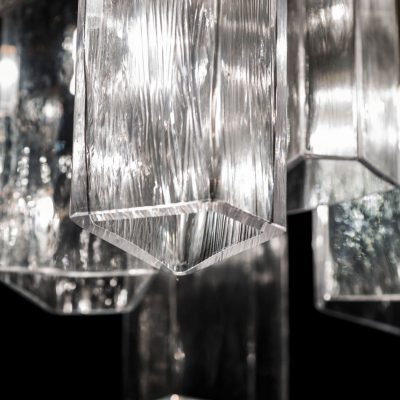Murano Glass
Material Focus

Henge explores the magic of a timeless element crafted by glassmakers’ hands that have mastered the centuries-old secret techniques found only in Murano.
There is a kind of beauty that nature is unable to supply. It is a kind of pure perfection of creativity and craftsmanship, of tradition and rarity: Murano glass, an element famed for centuries in every corner of the world. Murano glass is made exclusively on the Venetian island of Murano, where, for centuries, a legendary selection of artisans has specialized in making ornate glassware. They alone have the secret recipes to refine traditional techniques and the unrivaled know-how to develop new special technology. Their creative minds and skillful hands have led to a wide variety of Murano glass styles, including crystalline glass, enameled glass (smalto), glass with threads (aventurine), multicolored glass (millefiori), milk glass (lattimo) and imitation glass gemstones. Henge’s unwavering appreciation for the world of Murano glass has led to unforgettable collaborations with master glassmakers, such as Giberto Arrivabene Valenti Gonzaga. This partnership prompted the creation of extraordinary pieces including Air Light, an incredible composition of handcrafted lights and glass by the Murano masters. There is a special connection between this timeless material and Henge’s philosophy - one that restores tradition and flawlessly combines it with different, unexpected essences to represent a reimagined, well-balanced mood. The island of Murano, where the mystic spirit of this place still lingers, has developed into a timeless hub of knowledge through its many workshops. To preserve and share the local history of glass and glassmaking, the Murano Glass Museum was opened in Palazzo Giustiniano, the ancient residence of the Torcello bishops. It showcases collections dedicated to the traditional Murano glasswork along with its evolution starting from its conception, which is believed to be during the 8th-century with significant Asian and Muslim influences.
Murano glass is made up of 70% silica sand that is added to 30% of other substances called fluxes and stabilizers, principally soda and lime. This allows the glass to be melted at a lower temperature and prevents the glass’s solubility in water. With a lower melting temperature, the glass maintains a homogeneous, bubble-free texture, and it is typically colorless in its basic composition. Following the different styles produced over centuries of research, colors were obtained by adding small amounts of minerals and oxides. This is the magic recipe where ingredients change the nature of the glass, transforming it into the famed combinations associated with Murano glass, including light, transparent colors, crayons and alabasters.
Murano glass is made exclusively on the Venetian island of Murano, where, for centuries, a legendary selection of artisans has specialized in making ornate glassware. They alone have the secret recipes to refine traditional techniques and the unrivaled know-how to develop new special technology. Their creative minds and skillful hands have led to a wide variety of Murano glass styles, including crystalline glass, enameled glass (smalto), glass with threads (aventurine), multicolored glass (millefiori), milk glass (lattimo) and imitation glass gemstones.